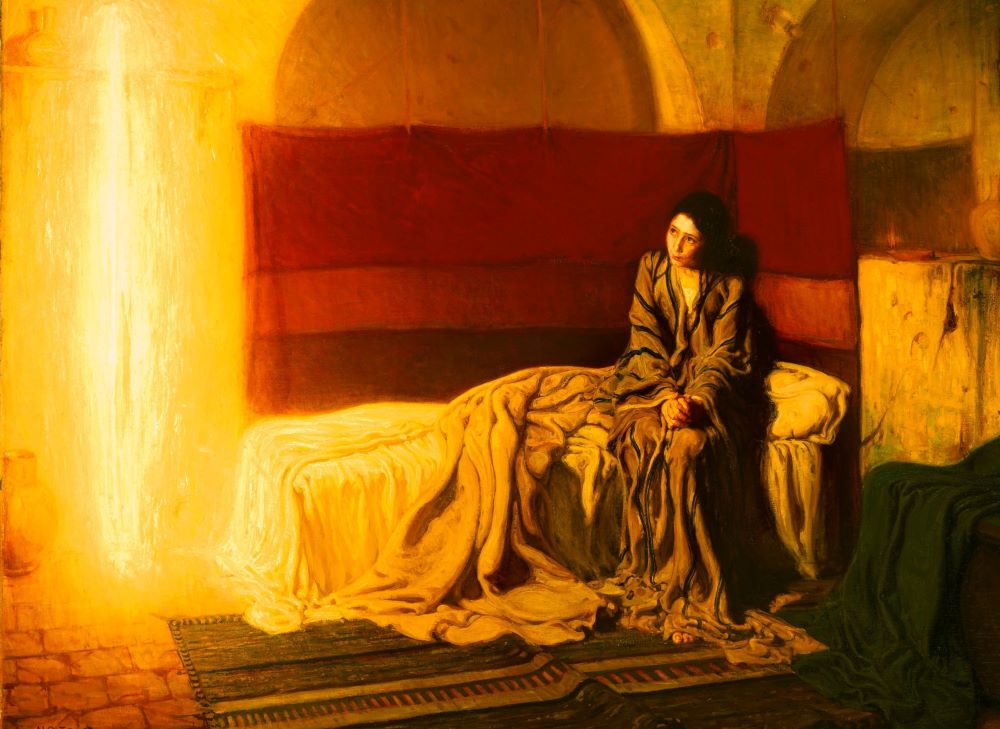
"The Annunciation" (1898) by Henry Ossawa Tanner (Philadelphia Museum of Art, www.philamuseum.org)
For years, I would buy a ticket to the Philadelphia Museum of Art for one thing and one thing only: "The Annunciation."
Ticket in hand, I would wind my way down the art-lined hallways of the museum to a gallery deep in the bowels of the American art wing. At times, it felt like I was making my way to the center of the earth, past presidential china and countless still life paintings, quilts and western landscapes, until I turned the corner into a gallery with raised ceilings and a few flat wooden benches.
And there it was: Henry Ossawa Tanner's "The Annunciation."
Sitting on the bench directly in front of the massive painting (over 6 feet tall and 7 feet wide), I would simply gaze on the glimmering canvas. On it, an adolescent girl in the humble dress of a peasant sits reservedly among the crumpled sheets of her bed. Clasping her hands, she looks at the beam of light before her. Her eyes reflect its glow, which illuminates the whole room with a gentle warmth. She has no halo, no shoes and, seemingly, no fear. This young Mary sits and looks intently. Her eyes are fixed on the light that we come to realize is Gabriel. The moment is sacred and still, speaking volumes.
From my seat on the bench, I would scan every inch of the painting. What, God, are you trying to say? What must she have felt, said, heard? Instinctively my hands would come together like Mary's, my fingers intertwining with hers in prayer. Were you scared or startled? Had you known all along there was something more meant for you? Was Gabriel's voice familiar like one you had heard a thousand times before? The light and its glow, a gentle reminder of the God who filled every day of your young life?
Shifting my focus from the light to Mary and back again, the minutes would fade into hours as my prayers filled the sanctuary of the gallery. Before I became a sister, this sacred space could hold the questions of "what if," and after I had entered into the process, there was a clandestine comfort in being hidden away in the cloister of culture the art museum provided. The what ifs continued and, in time, transformed. "What if this is what I'm being called to?" I would think as I looked at the shimmering canvas. The "this" was not just religious life but encounter with God. What if that call to encounter could be found in this moment? What if the annunciation was not a past occurrence or a beautiful work of art but a daily experience of living?
For, as comforting as that gallery was, I knew that the true annunciations of life took place out on the street level. There amidst the pressing demands of work and the noise of every conceivable need in the world, God was speaking to my heart. I just needed to stop long enough to let myself listen.
Advertisement
So often, that is the case. We rush from place to place, moment to moment, person to person, without pausing to recognize the light right in front of us. The temptation is to assign meaning to our doing rather than our being. I need to help one more person, encounter one more thing, accomplish one more task before the day is complete … I don't need to stop and listen. I already know what God is saying.
Or, perhaps consciously or unconsciously, we think : If I don't stop, I won't have to listen to what God might be trying to say. If I flood my day with news and noise, I can be concerned about that rather than truly bringing those things and my heart to prayer. Then when I pray, I will clasp my hands and eyes as well as my ears and heart, keeping the light at bay and holding on to control.
Unfortunately (or fortunately), that's not how annunciations work. God never shuts up and any crack can let the light in. Thinking of Mary poised on her messy bed I think of the image Beth Knobbe offers in her book Finding My Voice as she talks about not trying to hide anything from God. "God is like the girlfriend who stops by unexpectedly when my apartment is a mess," she writes. "Whether I am ready for company or not, she really doesn't mind." We don’t need to make a perfect setting, Knobbe insists. God will come in anyway. "God is the one who comes over and sits on the bed, while I rush around picking up clothes … she is more concerned about the conversation at hand than the dirty dishes in the sink."
This is the God who offers us everyday annunciations. Even if we are unresponsive or preoccupied, God continues the conversation at hand, be it through the people we encounter, the words we hear ourselves say, the nagging thoughts or feelings we return to, or the sense of unease that invites us to stop and sit for a little while.
From time to time as I sat before "The Annunciation," a tour group would make its way into the gallery. "Here we have one of the greatest American paintings ever," the tour guide would declare. Drawing my attention from the painting, the tour guide would motion toward a painting directly behind me: "The Gross Clinic" by Thomas Eakins.
Soon the tour group would surround me on my bench, their backs turned on the magical realism of "The Annunciation" to take in the gruesome testament to medical history and artistic realism the tour guide pointed out. Sitting with my hands folded, I wanted to shout: "Do you see what you're missing?!" — but I couldn't. Annunciations beg our attention on their own. Like shafts of light breaking into the gruesome reality of life, they invite us to something more. They invite us to recognize that, indeed, we are on holy ground, called and blessed, met by God in this very moment, messy as it may be.
With all that is going on in the world, it is the everyday annunciations that give us pause, to stop long enough to look intently and to say yes to the God who never stops speaking (or hoping) that we might open our hearts and our lives to listen and respond accordingly.







